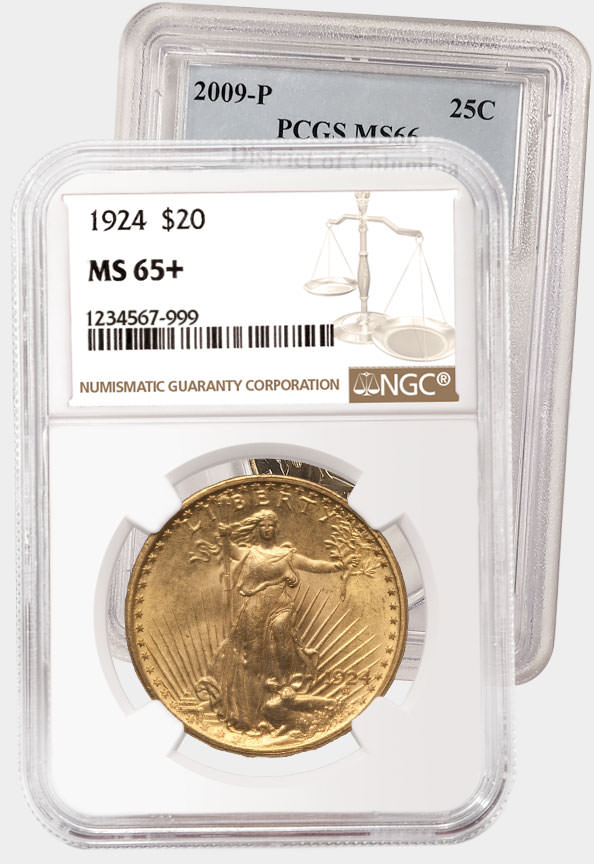NGC Ancients: Architecture on Ancient Coins
Posted on 4/11/2023
By
Ben Wallace
NGC Ancients Grader
When great cities are mentioned, iconic buildings often come to mind: the Statue of Liberty in New York, Big Ben in London, the Eiffel Tower of Paris and the Colosseum in Rome. Buildings have a way of becoming a part of a people’s culture and identity.
 |
A great example of this is the temple in Jerusalem, as shown on this silver Sela made in A.D. 133/4 during the Bar Kokhba Revolt. The obverse shows the façade of the Jerusalem temple with the Ark of the Covenant within, surrounded by the Hebrew inscription “Jerusalem.” The temple was an important religious and cultural symbol to the Jews even though the temple had been destroyed 60 years earlier by the Romans during the Jewish War of A.D. 66 to 70.
The reverse has a lulav and an etrog, both religious objects. The reverse legend is “year two of the freedom of Israel.”
The Romans were especially proud of the buildings and monuments they constructed. However, because their location was fixed, only a limited number of people could view these grand architectural achievements. This led many Roman rulers to issue coins depicting temples, arches, amphitheaters and ports to share their achievements with the rest of the empire.
While there are hundreds of ancient coins showing buildings, we’ll review just a few of them.
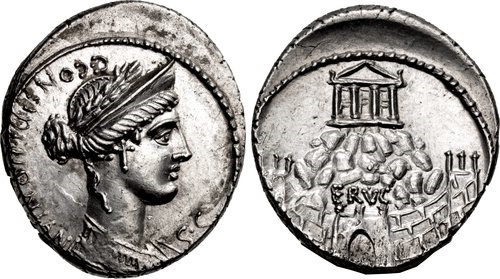 |
The Roman Republic denarius above shows an amazing temple scene. Made under the moneyer C. Considius Nonianus in 56 B.C., the obverse has the bust of the goddess Venus Erycina. The reverse shows her temple atop a rocky summit in Sicily, surrounded by fortified walls.
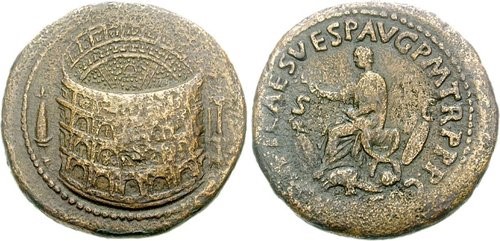 |
The greatest architectural icon of ancient Rome is the Colosseum, shown on the brass sestertius above. Built during the Flavian dynasty, the building was finished in A.D. 80, the same time this coin was issued. This sestertius was made under the emperor Titus (A.D. 79 to 81), who is shown on the reverse seated on a curule chair holding a branch surrounded by a pile of armor.
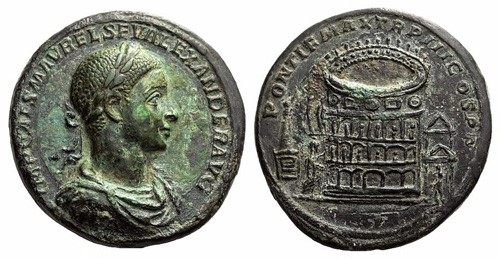 |
Also showing the Colosseum is this 37mm medallion for the emperor Severus Alexander (A.D. 222 to 235). It is bimetallic, with a copper center contained within a brass (orichalcum) outer ring. The obverse shows a youthful bust of the emperor. The reverse shows the Colosseum with the emperor sacrificing to the left. Above him is a large statue of Sol and to the right is a smaller building with a statue within.
Severus Alexander made this medallion to celebrate the rededication of the amphitheater after completing repairs needed due to a lightning strike.
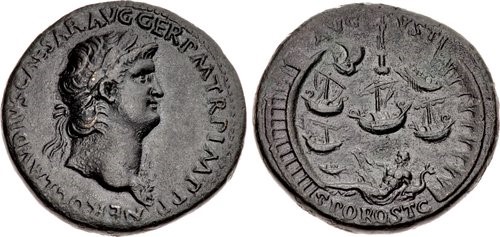 |
The above sestertius of the emperor Nero (A.D. 54 to 68) shows the Roman port at Ostia, the port of the city of Rome. It was located where the Tiber River met the Tyrrhenian Sea. The previous emperor Claudius (A.D. 41 to 54) began to expand this port during his reign, but it wasn’t finished until Nero.
The reverse is extremely detailed. The port’s lighthouse (pharos) is seen at the top of the reverse with a statue of Neptune upon it. At the bottom is the reclining figure of the Tiber River. In the port itself, we see seven ships, contained within warehouses and docks.
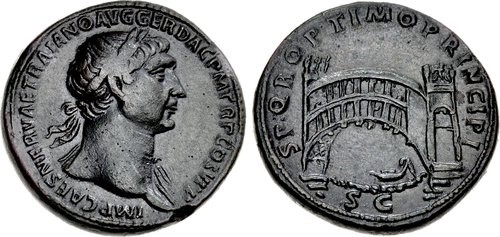 |
The above brass sestertius was made under emperor Trajan (A.D. 98 to 117). The reverse shows a large bridge with archways at both ends and a boat below. This bridge may be a symbolic representation of one that Trajan built across the Danube River on the Roman frontier. Sadly, that bridge did not survive long after its creation. Trajan’s successor, Hadrian (A.D. 117 to 138), destroyed it, presumably to better secure the borders from barbarian invasion.
 |
The large bronze drachm above was made in A.D. 133/4, during the reign of the emperor Hadrian, who is shown on the obverse. The reverse shows the goddess Isis Pharia holding a billowing sail as she heads towards the Lighthouse of Alexandria. The lighthouse is crowned with a statue and two Tritons blowing seashell trumpets.
This lighthouse was one of the seven wonders of the ancient world. It likely was over 300 feet tall and was both a lighthouse and a fortification for the city’s harbor. It survived until the late 1300s until a series of earthquakes damaged it. In the 1400s, it disappeared almost entirely when a fort was built upon its ruins.
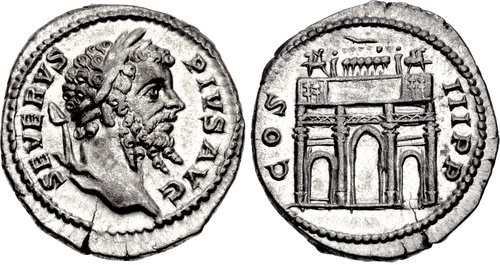 |
This denarius of the emperor Septimius Severus (A.D. 193 to 211) shows the archway built to commemorate his victories over the Parthians. The reverse shows a well-detailed engraving of the archway, including the statues upon it. Amazingly, most of this arch still survives in Rome to this day.
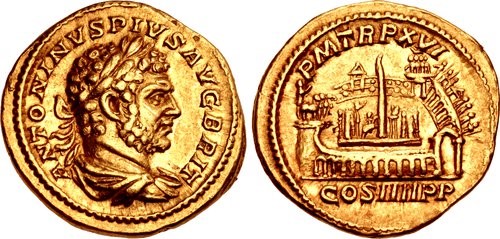 |
This amazing gold aureus of the emperor Caracalla (A.D. 198 to 217) shows the Circus Maximus in all of its glory. It was a huge racetrack in Rome that could hold around 150,000 people. Roman emperors often added to, renovated or expanded this arena. Caracalla issued this coin to commemorate his own renovations. The Circus Maximus was an important part of life in Rome but sadly, not much of it is left today.
The amount of detail on this design is astounding. In the middle is a large obelisk of the pharaoh Ramesses the Great brought from Egypt by Rome’s first emperor, Augustus. To the left of the obelisk is a statue of the emperor Trajan on horseback. To the right is a shrine to the goddess Cybele. In the periphery are a variety of structures and statues, including a triumphal arch, temples, porticoes and gateways.
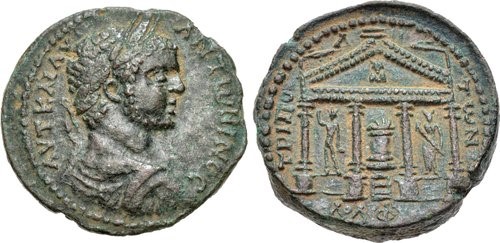 |
The above 28mm bronze was made at the Phoenician city of Tripolis during the reign of the emperor Elagabalus (A.D. 218 to 222). The obverse shows the bearded bust of the young ruler. The reverse has a well-detailed tetrastyle temple with a flaming altar to Zeus Hagios inside. Statues of Sol and Luna are shown to the sides of the altar.
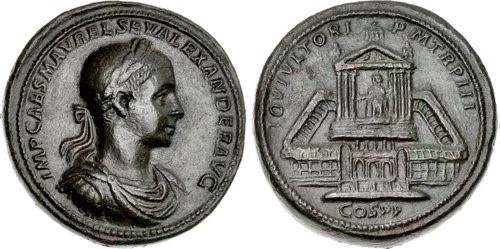 |
Rounding out our survey of Roman architecture is this fantastic 37mm medallion of the emperor Severus Alexander. The reverse shows an aerial view of the Temple of Jupiter Ultor. A statue of the god can be seen in the main temple, placed within a walled complex and porch.
The previous emperor, Elagabalus, had expanded this temple and rededicated it to the Eastern god El-Gabal. After the murder of Elagabalus, his cousin Severus Alexander quickly rededicated the temple to Jupiter, the likely reason for the issue of this impressive medallion.
Images courtesy of Classical Numismatic Group.
Interested in reading more articles on Ancient coins? Click here.
Stay Informed
Want news like this delivered to your inbox once a month? Subscribe to the free NGC eNewsletter today!
